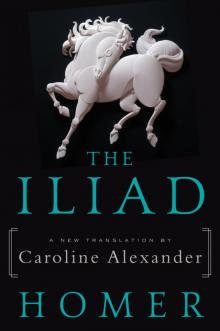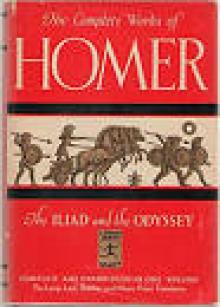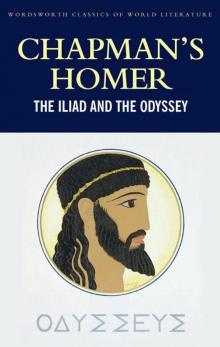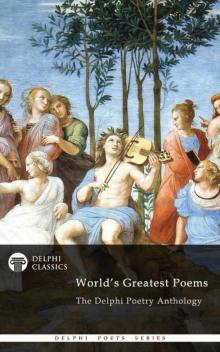The <I>Odyssey</I> Read online
THE ODYSSEY
Johns Hopkins New Translations from Antiquity
Homer
THE ODYSSEY
Translated by Edward McCrorie
With an introduction and notes by
Richard P. Martin
© 2004 The Johns Hopkins University Press
All rights reserved. Published 2004
Printed in the United States of America on acid-free paper
9 8 7 6 5 4 3 2 1
Johns Hopkins Paperbacks edition, 2005
The Johns Hopkins University Press
2715 North Charles Street
Baltimore, Maryland 21218-4363
www.press.jhu.edu
The Library of Congress has cataloged the hardcover edition of this book as follows:
Homer.
[Odyssey. English]
The Odyssey / Homer ; translated by Edward McCrorie ; with an introduction and notes by Richard P. Martin.
p. cm — (Johns Hopkins new translations from antiquity)
Includes bibliographical references.
ISBN 0-8018-6854-8 (hardcover: acid-free paper)
1. Odysseus (Greek mythology)—Poetry. 2. Epic poetry, Greek—Translations into English. I. McCrorie, Edward. II. Title. III. Series.
PA4025.A5M43 2004
883'.01—dc22 2003021372
ISBN 0-8018-8267-2 (pbk.: acid-free paper)
A catalog record for this book is available from the British Library.
To Richard Wilbur
Contents
Translator’s Preface
Introduction, by Richard P. Martin
THE ODYSSEY
1 : Trouble at Home
2 : A Gathering and a Parting
3 : In the Great Hall of Nestor
4 : With Menelaos and Helen
5 : A Raft on the High Seas
6 : Laundry Friends
7 : The Warmest Welcome
8 : Songs, Challenges, Dances, and Gifts
9 : A Battle, the Lotos, and a Savage’s Cave
10 : Mad Winds, Laistrugonians, and an Enchantress
11 : The Land of the Dead
12 : Evil Song, a Deadly Strait, and Forbidden Herds
13 : A Strange Arrival Home
14 : The House of the Swineherd
15 : Son and Father Converging
16 : Father and Son Reunited
17 : Unknown in His Own House
18 : Fights in the Great Hall
19 : Memory and Dream in the Palace
20 : Dawn of the Death-Day
21 : The Stringing of the Bow
22 : Revenge in the Great Hall
23 : Husband and Wife at Last
24 : Last Tensions and Peace
Notes, by Richard P. Martin
Names in the Odyssey
Bibliography, by Richard P. Martin
Translator’s Preface
The experience of Homer’s Odyssey, like that of life itself, is one of joy and jitters, wonder and setbacks, the struggle and rewards of a long journey home. An early chapter of my own journey took place in a curious dream some years ago before I began translating Homer. Flying 40,000 feet over the Atlantic I was asked by a woman next to me, “Where are you going?” I answered promptly, “Mycenae.”
I woke up thinking that was an alluring destination. In a later chapter of my journey I stood among the excavated ruins of Homer’s Mukenai (pronounced by him, roughly, moo-KAY-nai), gazing down at the plain of Argos, still quite green. I touched a circle of shadowy earth where, if Heinrich Schliemann was right, the central hearth-fire of Agamemnon himself had burned. That autumn of 1992 I could not confirm or deny the dream was sent to me by Pallas Athene (PAHL-luhss ah-THAY-nay), but I felt I should pay it some attention. In this Preface, therefore, I’d like to describe one man’s Odyssey journey, hoping my readers will be as patient and understanding as Homer’s Phaiakians. The style and substance of the present translation evolved over a number of years with a great deal of help; some of my critics I think as “godlike” as Homer’s swineherd, Eumaios.
In the days following that dream I looked for an old Greek grammar I’d used in college. For some reason I’d never thrown it away. It brought back memories of college teachers roused by Homer, lengthening the Greek vowels and sweating out the perils of Hektor and Odysseus before my eyes. The rugged sound and often harrowing sense of Homer began calling to me; but many hours lay ahead on the distant shore of that grammar. A bevy of hard verbs in particular detained me.
As Odysseus often had a problematical course to map out, right from the start translators have the Greek-into-English line to grapple with. Homer often moves rapidly in hexameters with a subtle timbre and texture of vowels and consonants, with varied and dramatic pauses: how to render all that into contemporary English poetry? Having labored through Shelley’s style for my doctoral dissertation at Brown and having tried to approximate the music of Virgil in a translation of the Aeneid, I wondered if I might adapt that English line for my Odyssey work, since the meter of Virgil and Homer is the same—dactylic hexameter. I wanted to avoid, however, a runaway hexameter line like that of Longfellow in Evangeline.
The crux, I knew, lay in the dynamics of Homeric verse. It’s called “dactylic” but not all six metrical units need be dactyls, scanned / × ×, as in “POWerful.” Virgil and Homer in fact were obliged to provide a dactyl only in the fifth unit, or “foot.” (Even there they don’t always obey.) What this means is that both poets enjoyed a wide range of rhythmical flexibility, for example using more dactyls to speed up a line or more spondees to slow it down—two “long” syllables together, the English counterpart scanned / /, as in “great hall”—depending on the emotional and narrative substance of the passage. For the Aeneid and then the Odyssey I evolved a similar line, using English “accentual” verse. It resembles Homer in that it counts the number of “longs” or stresses but lets the number of “short” or unstressed syllables vary. A famous example is the four-stress line of Beowulf. Of course for Homer as for Virgil I needed to extend that line to five and sometimes six stresses. I also decided to end most of my lines, following the ancient epics, with a dactyl-trochee (/ × × / ×) or dactyl-spondee (/ × × / /) combination. Thus in the opening lines of book 2:
Style of course does not exist apart from a poet’s deepest convictions and feelings. For a firmer grounding in Greek style and experience I thought it wise to travel, to actually sail the seas and walk the lands made famous by Odysseus. I’m grateful to Providence College for a study grant to that end. This time while flying to Athens and gazing down at the Mediterranean I recalled serving as a young man aboard the USS Leyte, an aircraft carrier that hunted for nuclear-powered sea-beasts and disgorged rowdy, hubristic sailors on the shores of Piraeos, Krete, and Rhodes. Our skipper slashed no cables or throats of rams but his crewmen relished enough wine and beef, roasted (I liked to imagine) by Odysseus’s descendants. Now I sought out Homer in small boats on hazy seas, among gruff men on city streets, proud of their muscle and savvy. I looked through pottery collections in the Athens Archeological Museum and found the Odyssey’s women and goddesses in black and red. Along the jade-green Alpheios River, flowing all summer long near Olympia, I saw the spirit of Homer himself sounding out his lines in the Games over 2,700 years ago, strumming his phorminx, and garnering the laurels in honor of Zeus. In Patras I discovered the taste of Mavrodaphne, a strong, sweet wine that would brace me before entering the cave of a giant. On the island of Corfu—Kerkyra, the legendary home of Alkinoos and the Phaiakians—a Greek mother and her family extended warm hospitality to a xeinos, their stranger-guest from America.
All roads and waves led finally, it seemed, to Ithaka. I stood on a ridge near Mount Aetos with a view so perfect to east and
west that I wanted to build a house there. Odysseus did just that, according to Sarantis Symeonoglou, the archaeologist heading up the Odyssey Project from Washington University in St. Louis. He gestured down one evening to his latest excavation with its “Cyclopean” construction—stones so large that only a giant, supposedly, could place them. Resembling the stones of Mukenai, they clearly established the presence of a people here like Agamemnon’s during the Trojan era some 3,300 years ago.
In time my Odyssey journey took me back home to America with armfuls of maps, books, conversation notes, and the makings of poems like “Paxos Women,” published a few years later in Columbia. The journey was often intellectual and cultural in stateside museums with their own collections of ancient Greek artifacts, in essays about Homeric plant life in the Peloponnese, in drawings and photographs of birds and mammals in ancient and modern Hellas. But no doubt visiting or corresponding with other poets and classicists became the keenest pleasure. William Wyatt at Brown, for instance, offered me valuable advice about overintellectualizing a translation of Homer—and invaluable advice about the danger of using too much Latinate diction. Rely on a forceful English, he would say, stay close to your Anglo-Saxon roots.
Exploring the work of other translators of Homer was another heady and heartening chapter in this Odyssey journey. They represented an amazingly broad spectrum of literary assumptions and line-by-line strategies. Grouped at one end of the spectrum were those I began to call free Homeric spirits. Chapman and Pope, for example, had paid keen attention to color, drama, and vivacity of style, rendering Homer loosely and imaginatively. Their aim in fact was to generate a kind of love, a passionate devotion to Homer among their contemporaries. So too in the twentieth century, Fitzgerald and Fagles (to name only two) paid less attention to the technicalities of Homeric verse and more to an inventive American style in their mother tongue. Their principal aim, like that of Chapman and Pope, was to arouse new attention and delight in the generation of English readers at hand.
Grouping toward the other end of the spectrum were those I came to think of as close followers of Homer. Well-trained in the classics, often lovers of every nuance of the Greek, less concerned with passing styles of English poetry, they worked hard to produce faithful translations of the Odyssey. Lattimore’s work was a prime example in the twentieth century. He took a bold chance by lengthening the English line for his Homer, aiming at more fidelity to both sense and sound. Many other translators in this group, however, were so concerned about accuracy that they turned to prose. Although they lost nearly all of the Odyssey’s music, translators like Murray and Dimock (in the Harvard Loeb edition) did focus on clarity and correctness for their readers.
Might a translation somehow do both? Having aimed at a close approximation to the sound and sense of Virgil’s Latin, I initially felt like a member of the second group, the close followers of Homer. I certainly wanted to avoid a free translation that might move in the direction of rewriting the original in what Robert Lowell called “imitation.” But I also continued to entertain the possibility of a brisk twenty-first-century English idiom for Homer. When the attainment of both ends, fidelity and freedom, struck me as truly daunting, two eminent forebears gave me hope. William Arrowsmith had written a sly summation of the translator’s twofold obligation in his excellent Petronius: devoted to the Latin as though to a wife, he confessed a greater devotion to his English mistress. But exactly how, day by day, can a translator render Homer’s Greek faithfully and still remain close to English poetry now? A solution came from my other forebear, Richard Wilbur, who has graciously accepted the dedication of this work. I credit him (though in his modesty he may pass along the credit) for an idea so wonderfully paradoxical that it constantly baffles my poetry students: a close adherence to form may actually have the effect of liberating, not constraining, the poet-translator. At one point Wilbur expressed concern about my trying to stay too close to Homer’s orchestration. But I could not resist the model of his Molière. How remarkably devoted to the French and to his own English! Someone has wittily paid him the highest compliment: Molière would insist, if he were alive, that he had beautifully translated Wilbur.
So I aimed at both fidelity to Homer and all the vitality I could muster in English. Perfection was never the goal; I aimed at a good approximation. To that end, since Wilbur’s Molière also played so well on the stage and emphasized poetry’s performance, the next chapter of my journey took me into recordings and live readings of Homer. They were sadly disappointing. Little or no attention was paid to the Greek metrical patterns; readers generally followed the accent marks, or diacritics, placed in the text after Homer’s time. Now of course we’ll never know exactly how Homer sang his poetry. But we do know how his meter is scanned and it’s unimaginable to me, as a poet, that he largely ignored those rhythmical patterns in oral presentation. I suspect in fact that he stressed the meter vigorously as a singer (aoidos), probably like our contemporary folksingers with their guitars, emphasizing both the words and the beat.
How, then, should the lines in the present translation be performed? Hamlet tells the players not to mouth his lines: no one appreciates a performer who overemphasizes the iambs—da-DUM, da-DUM—in a Shakespeare soliloquy. Some lines in this translation develop an iambic pattern briefly, while others are trochaic (DUM-da, DUM-da); others are a mix of these two or others (like the dactyls noted above, DUM-da-da); in all I tried to orchestrate, as Homer usually does, the mood and pace of the moment. I also took the advice of Donald Hall and tried occasionally to abut strongly accented syllables. A common tactic in English accentual verse, it can prevent the line from overaccelerating. Two fairly simple verses about Penelopeia should illustrate. (I refer the reader to the Glossary for an explanation of the spelling and pronunciation of such names, in this case, following the Greek meter, PAY-neh-law-PAY-uh.) Homer describes her in book 19 (lines 600–601) leaving the great hall of the palace:
In the scansion, / represents an accent or stress, × an unaccented syllable, | a short pause (or caesura), and || a longer pause. This English line contains five or six stressed syllables and a varying number of unstressed syllables, approximating Homer’s hexameter line with its six “longs” and varying number of “shorts.” The rhythm in line 600 is trochaic at first, “HAving SPOken,” with a brief caesura, or pause. It rises briefly as the queen ascends, “she WALKED upSTAIRS,” and the line ends, like Homer’s, with a characteristic dactyl-trochee combination, giving the line a brief acceleration: “STAIRS to her GLOWing.” Matthew Arnold was no doubt right to call Homer’s line “rapid”—English blank verse or iambic pentameter is definitely slower—but the Odyssey’s rhythm often slows down to underscore a somber or tense moment. Here my line 601 has three stressed syllables in a group of four, with a heavy pause as well—“NOT aLONE: HAND-”—suggesting the queen’s closeness to and emotional need for her handmaids, their “crowding” together.
Readers will have little trouble with all this, I think, if they don’t have high or rigid expectations about the epic line in English having to be iambic, dactylic, or something else. This rendering of Homer can be read aloud enjoyably and naturally, though a little help from a phorminx or some other tightly strung instrument would help. If only we had recordings of Homer winning the laurels at the first Olympic Games!
In time my frail translator’s craft took me more deeply into the caverns of Homeric style. As with Virgil I began paying close attention to Homer’s vowels, diphthongs, and consonants. I noticed how often eta appears in the Odyssey, for example, designating a sound close to our mare. On the other hand iota, with its long ee or short ih sound, tends to appear less often, especially in Homer’s long syllables. Now all sorts of translation theory and practice flourished in the twentieth century and someone like Rosemary Waldrop might have produced an engagingly musical imitation of Homeric vowels in her English without worrying about literal fidelity—and without failing to produce a strange new Homer. This translation, on th
e other hand, aimed at both sometimes—the retention of Homer’s key vowels and the passage’s meaning in English. Thus in the well-known line (2.1 and elsewhere) about the day’s beginning—
êmos d’ êrigeneia phanê rhododaktulos Êôs—
which in English transcription probably would sound like
HAY-moss DEY-rih-gheh-NAY-uh phuh-NAY rhaw-daw-DAHK-too-lawss AY-ohss—
four eta s appear as “long” syllables and the diphthong, ei (epsilon and iota), has a similar sound. That’s a good deal of assonance; no translator could replicate all of it. My version captures two of the etas:
When newborn Dawn came on with her rose-fingered daylight—
and I also echoed Homer’s dahk- with my “on” and his -ohss with my “rose.” On the other hand I replicated only one of Homer’s five omicron sounds (as in the second syllable of êmos, HAY-moss) with my “Dawn.” This sort of thing became possible less frequently with Homer than with Virgil, probably because ancient Greek differs more radically than classical Latin from modern English. When in doubt I let the demands of current English make the final decision. Still it was often exciting, if sometimes overweening, to match Homeric sound and sense to current English music and meaning.
Besides, other real ghosts confronted me soon enough in the caverns of Homeric style. Milman Parry has famously demonstrated how one phrase after another in the epics, whether a personal description, a verb or a noun phrase, fits neatly into the metrical notches of that line. Such diction-and-meter combinations, often names with adjectives or epithets at the end of a line, undoubtedly helped the singer’s memory; but for the modern translator they pose considerable problems. Odysseus is often dubbed polumêtis, a word suggesting a plenitude of strategies. Should the translator drop the epithet if it has appeared a few lines earlier? Some have seen it as filler in the verse and dropped it altogether; still others have rewritten the phrase to please the modern American ear.

 The Odyssey
The Odyssey The Iliad
The Iliad The Iliad (Trans. Caroline Alexander)
The Iliad (Trans. Caroline Alexander) Complete Works of Homer
Complete Works of Homer The <I>Odyssey</I>
The <I>Odyssey</I> The Iliad and the Odyssey (Classics of World Literature)
The Iliad and the Odyssey (Classics of World Literature) Troy
Troy The Iliad (Penguin Classics)
The Iliad (Penguin Classics) Delphi Poetry Anthology: The World's Greatest Poems (Delphi Poets Series Book 50)
Delphi Poetry Anthology: The World's Greatest Poems (Delphi Poets Series Book 50)